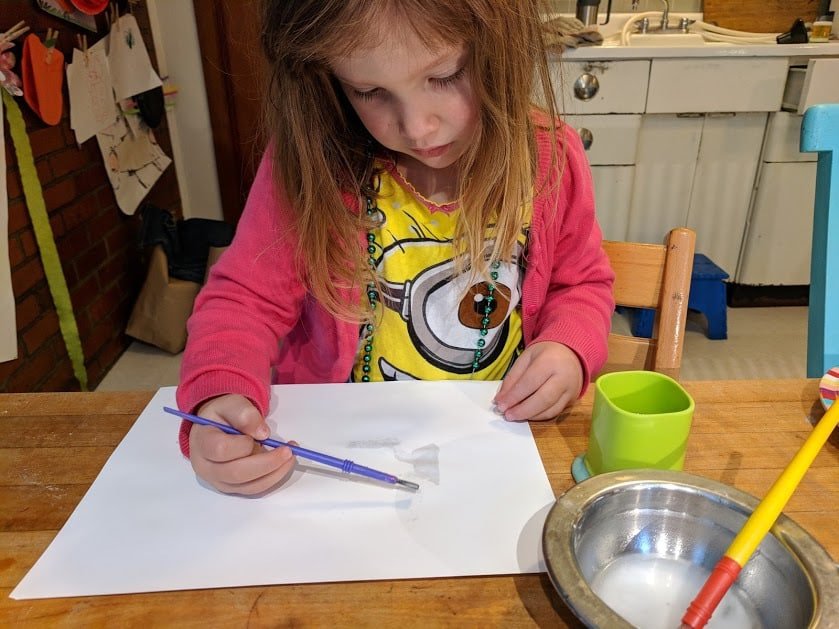Secret Spy Letters – Using acid/base indicators for fun!
The spice trade did more than bring riches to merchants and flavors to royalty. It helped create empires, tipped the balance of world power, and even discovered an entire continent (hey North America)! Back then spice routes were heavily guarded, the Portuguese kept a lock on the spice trade commanding the security of sea routes in the Indian ocean. They had such a lock that other countries took to hiring spies to attempt to establish spice trade routes of their own.
In this fun Thanksgiving STEM activity you will become your own spy and write secret messages, or draw secret maps. You wouldn’t want anyone else knowing all your information, right? All you need to write these secret messages is baking soda and water. To reveal them we will use cranberries!
How to use acids and bases to write a secret spy message.
- Make your paint base
- Paint or write your secret spy message.
- Let your secret spy message dry.
- Reveal by spraying cranberry juice over the page.
1. Make your paint base
Dissolve a few tablespoons of baking soda into a cup of water. Baking soda is basic, which means it has a high pH. By dissolving baking soda into the water you are changing the pH of the water from pH7 to something greater (like a pH 10). Cranberries contain anthocyanin, a compound that changes its conformation, and thus color, as a function of the local pH.
2. Paint or write your secret spy message.
Use your well mixed high pH water to paint on white paper. Larger, thicker strokes are seen easier, but you could use a quill or other type of inkless writing tool to write an actual letter.
3. Allow your message to dry.
In the beginning, you can see your art since the water will be darker where it is wet. Once it is dry, however, your message will be concealed. Now you can send your “blank” message back home to help your countrymen discover the best secrets in the spice trade!
4. Reveal your message with cranberry juice.
To reveal the messages you will need to spray them with a cranberry concoction. Boil half a bag of cranberries for about half an hour. I like to keep a lid on the pot so the cranberries don’t jump out when they pop from cooking. Let the concoction cool and load it into a spray bottle. We found that the finger pump sprays (like what you find on hairspray) were hard for little hands. If you can find one, use a spray can that has the full hand pump on it (like a Windex bottle).
Once your concoction is cool you can spray it over the white paper to reveal the message. Your page will have the red from the cranberry mixture, and be a blue/green where the baking soda was laid down! You can even experiment with painting with lemon juice to get a third color in your secret message! It could be a double trouble super secret!
Thrive Leads Shortcode could not be rendered, please check it in Thrive Leads Section!
How does this cranberry chemistry project work? Why does your spy message appear in a different color?
This super spytastic cranberry message encoder works similarly to the purple cabbage pH indicator. Cranberries, like purple cabbage, are stock full of anthocyanins – which is what gives them their bright red color.
How do anthocyanins work?
Anthocyanins are a compound consisting of multiple ringed structures with lots of -OH and -H hanging off. In chemistry, -OH can easily detach and join us with extra H ions in acids to create water, while extra -H can do the same but team up with the OH of bases. That means depending on the acidity of the solution, anthocyanins can change their structure. That structural change is one that we can see in terms of its color! It’s somewhat mind-blowing to think that the color changes you see in this project (and the purple cabbage pH lab) are molecular changes, you are seeing the movement of molecules with your own eyes! You can dig deeper and learn more about anthocyanins in our Purple Cabbage Lab!
Where can I find anthocyanins?
Anthocyanins are found all around you. They are jam-packed in dark blue and red fruits or veggies, like beets, purple cabbage, blueberries, blackberries, even in turmeric, the spice! Anthocyanins are also why our leaves change color. As the green chlorophyl recedes when a tree prepares to hibernate in the winter we see the work of anthocyanins that were lurking under the surface.
Did spies really use invisible ink?
Yes! Some invisible inks that spies used were actually revealed through the application of heat. Spies could write in an acidic solution, like lemon juice, which would appear invisible. Then by applying a candle flame, you could reveal the message as the parts of the paper written on in acid would turn brown faster. This project is a different type of invisible ink, called sympathetic ink. These inks use a second chemical (in this case cranberry juice) to reveal the message.
During the revolutionary war, George Washington often used sympathetic ink to communicate supply locations, troop movements, and battle plans. Invisible inks were even used in WWI!





9 thoughts on “Secret Spy Letters for Thanksgiving Fun”
Comments are closed.